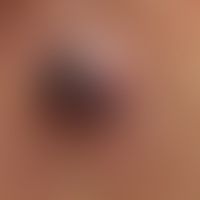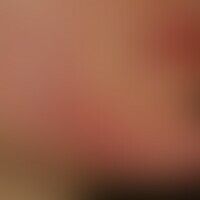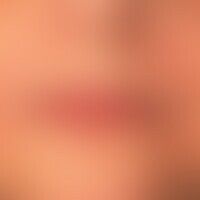
Wrinkle treatment
Wrinkle treatment with filling materials: the ideal filling material is biocompatible, without allergenic potential, has a good long-term result, no side effects and a natural appearance. 8 weeks after injection of an unknown filling material, development of foreign body granulomas, which can be felt as solid deep conglomerates.
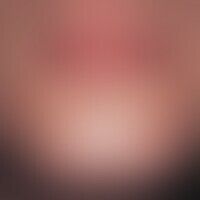
Contact acne L70.83

Gianotti-crosti syndrome L44.4
acrodermatitis papulosa eruptiva infantilis. exanthema of a few days old on the face, on the trunk (very discreet) and the extremities. disseminated, 0.2-0.4 cm large, red to reddish-brown papules with smooth surface. on the earlobe flat, succulent erythema with several, in places aggregated, rich red papules and vesicles.

Rosacea L71.1; L71.8; L71.9;
Rosacea lupoide: non-itching, multiple, follicular yellow-brown papules that have existed for several months DD: demodex folliculitis can be ruled out
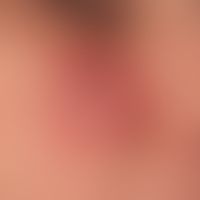
Lupus erythematodes chronicus discoides L93.0
Lupus erythematodes chronicus discoides: succulent, hyperesthetic plaque with adherent scaling, 2.7x3.2 cm in size, existing for 4 months, no evidence of systemic LE. DIF with typical pattern.
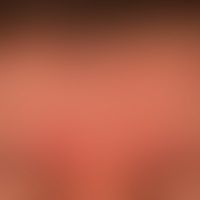
Seborrheic dermatitis of adults L21.9
dermatitis, adult seborrhoeic: partly small spots, partly blurred erythema with small lamellar scaly deposits. slight feeling of tension. no significant itching. skin changes have existed for years to varying degrees. in summer, clearly improved or completely disappeared.

Psoriasis vulgaris L40.00
psoriasis vulgaris. localized psoriasis. no further foci! chronic dynamic, red, rough plaque covering the entire left orbital region. in addition, in the 60-year-old woman, discrete, red, slightly scaly plaques have existed for several years on the elbows, knees, sacral region, rima ani, scalp and ears (retroauricular accentuation).
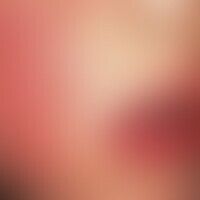
Erythema perstans faciei L53.83
Erythema perstans faciei. persistent, butterfly-shaped, livid red erythema in a 3-year-old boy with vitium cordis (pulmonary stenosis, subaortic stenosis, vascular transport and ventricular septal defect).
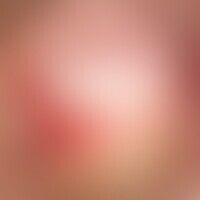
Ain D48.5
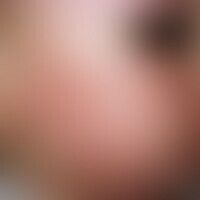
Acne infantum L70.40

Giant keratoakanthoma D23.-
Giant keratoakanthoma: 6 cm in diameter large, painless lump, which initially grew very quickly, but now for several months no detectable size growth.
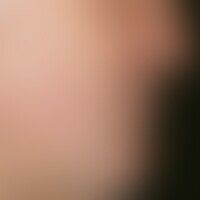
Tinea barbae B35.0
Tinea barbae. scaly, blurred, itchy erythema (incipient plaques) on the cheek and upper lip. erythema areas are sparsely interspersed with follicular papules and pustules.
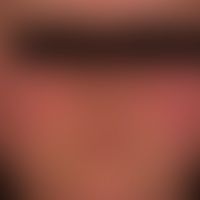
Rosacea L71.1; L71.8; L71.9;
rosacea. rosacea erythematosa, stage I of rosacea with individual inflammatory papules and pustules. flat, relatively sharply defined, symmetrical erythema (plaque) of the cheeks with clear protrusion of the follicles (skin pores). no comedones. perioral area remaining free. redness is now permanently present after earlier volatility but with varying intensity. at the same time, a feeling of tension and a slight burning sensation with shearing activity.

Rosacea L71.1; L71.8; L71.9;
Stage I-IIrosacea (rosacea papulopustulosa) In this 34-year-old female patient, single, recurrent red papules and pustules have been present on the nose, cheeks and chin for about 4 years.
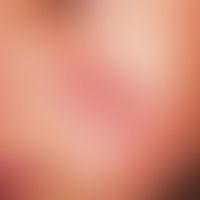
Leishmaniasis (overview) B55.-
Leishmaniasis, cutaneous (classic oriental bulge):roundish, reddish plaque appearing several weeks after a holiday in Mallorca with central erosion.
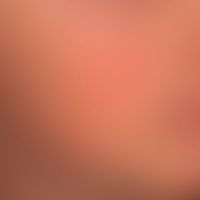
Erythema perstans faciei L53.83
Erythema perstans faciei: symmetrical, changing redness of both cheeks (here circled) Fixed erythema on chin and cheeks marked with arrows.

Scleroderma systemic M34.0
Scleroderma, systemic: within 2-3 years, newly developed telangiectasia of the facial skin.

Borrelia lymphocytoma L98.8
Lymphadenosis cutis benigna: painless, non-itching, calotte-shaped, firm red lump that has been present for 3 months, no scaling.

Seborrheic dermatitis of adults L21.9
Dermatitis, seborrhoeic: Flat, symmetrical (butterfly-like - DD: rosacea, systemic lupus ertyhematosus), blurred, location-constant and therapy-resistant, coarsely scaly red plaques.

